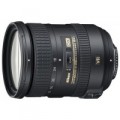Main function
The general purpose is rather conditional, and in fact the use of optics is not limited to the claimed direction — it all depends on the skills and imagination of the photographer. However, information about the specialization can greatly facilitate the choice. Considering such original options as a
cinema lens and
a multifunctional.
—
Architectural. Lenses designed primarily for shooting buildings. Most of these models are equipped with the Tilt-Shift system (see below). In this case, this function is intended to correct the perspective when shooting tall buildings. In a photograph taken with a normal lens, straight lines can turn out to be curved, which is unacceptable in cases where an accurate representation of the building in the picture is required. Using the Tilt-Shift system allows you to avoid this phenomenon and get a reliable image that does not require additional correction in a photo editor.
—
Landscape. In this case, landscape lenses include short-focus (wide-angle) lenses, which, according to test results, provide good image sharpness. In other words, not all “wide-angles” are classified as landscapes, but only those that are actually capable of providing a clear, sharp image.
—
Portrait. The hallmarks of a classic portrait lens are: first, the fixed focal le
...ngth, which is usually over 50mm (35mm equiv.); secondly, high aperture (most often not lower than f / 2.8, although occasionally there are exceptions). This combination of characteristics allows you to shoot portraits with beautiful background blur, placing the camera at a fairly significant distance; the latter can be useful in studios where additional lighting equipment is used — it is advisable to install the camera behind lighting fixtures so that it does not give a shadow. Speaking of a fixed focal length, it is worth recalling that "fixes" are simpler, lighter and cheaper than zoom lenses, and the ability to adjust the magnification when shooting portraits is rarely required — most often you can completely get by with "zoom with your feet".
— Multifunctional. This direction includes lenses of a universal type (see above), offering the buyer a good value for money; in other words — multi-purpose models with good performance and at the same time relatively inexpensive (namely, "comparatively", the actual price can be quite high). When choosing models in this category, the quality of filming was evaluated according to the results of real tests.
— Film lens. The main feature of cinema lenses is the ability to fine-tune the aperture. The aperture can be closed / opened by 0.1 or even 0.01 mm, while in photo lenses the aperture setting step cannot be less than 1 mm. Additionally, in cinema lenses, aperture is expressed by a T-number, and in photographic lenses, an F-number is used. The operator can shoot multiple cinema lenses with the same aperture, without the need to change the lighting. And when using photo lenses with the same aperture, you often have to adjust the lighting for each optic separately. Cinema lenses are meant to be shot from a tripod, which is reflected in their design features and design — such models are usually larger and heavier than their counterparts for photography.Viewing angles
This parameter determines the size of the area of the scene being shot that falls into the frame. The wider the viewing angles, the larger the area the lens can capture in one shot. They are directly related to the focal length of the lens (see "Focal length"), and also depend on the size of the specific matrix with which the optics are used: for the same lens, the smaller the matrix, the smaller the viewing angles, and vice versa. On our website, in the characteristics of optics, viewing angles are usually indicated when used with the matrix for which the lens was originally designed (for more details, see "Matrix Size").
Internal focus
Lenses using the
internal focus system. In such optics systems, focus is carried out only due to the movement of elements inside the lens body; the outer parts remain completely fixed and the size of the lens does not change. This provides additional convenience — in particular, it allows you to easily use petal hoods and those types of filters for which the correct position on the lens is important (in particular, gradient ones). In addition, the absence of moving elements from the outside has a positive effect on security and resistance to dust / precipitation (although the specific degree of dust and water protection may be different).

